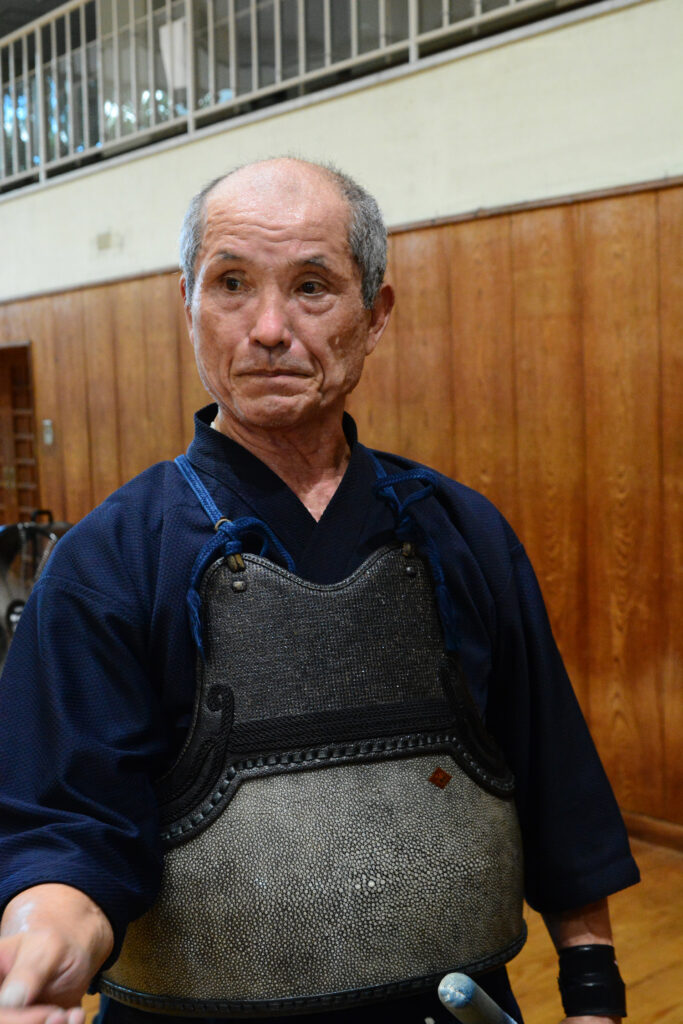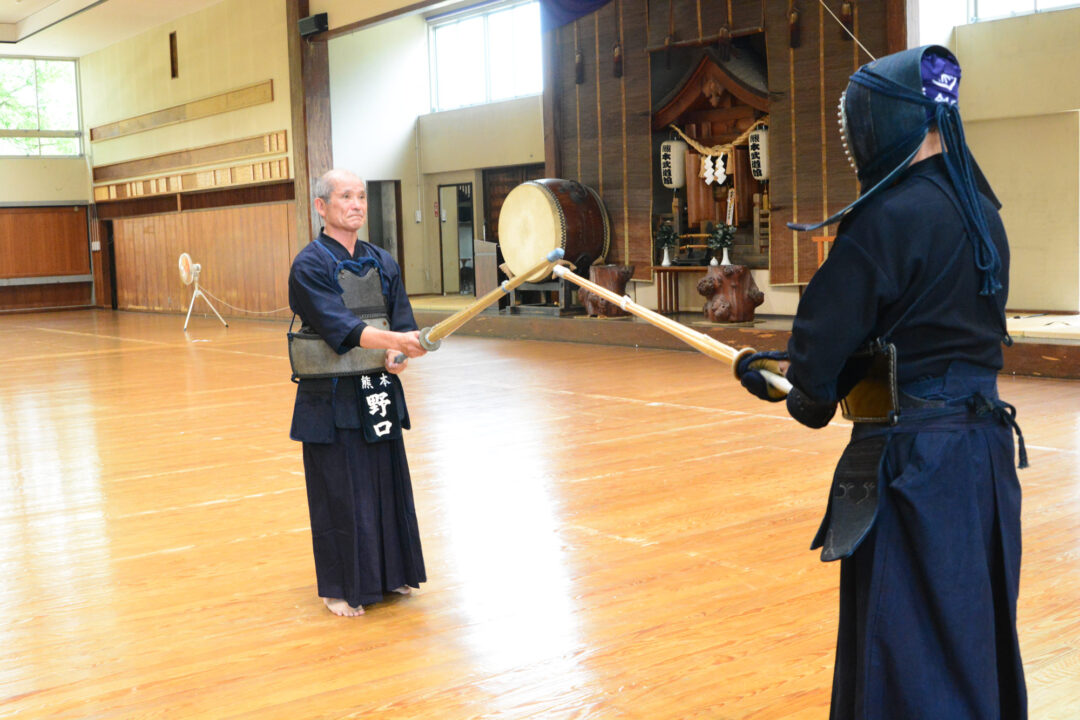2024.11 KENDOJIDAI
Translation: Pepijn Boomgaard
The reason why high ranked Sensei are able to overpower younger players is because they have the adaptability to make up for the physical difference. Noguchi Sensei was taught adaptability training by his lifelong master Nakano Yasoji (Hanshi 9th Dan). In order for your Kendo to be able to respond to any opponent, it is important to gain experience and increase the knowledge you can use to handle things impromptu.
Noguchi Shinichiro (Hanshi 8th Dan)

Kendo allows older people to compete against younger people on equal terms. In fact, there are many occasions when even young All Japan champions are overwhelmed by their older teachers in practice.
I have seen many times how younger players who are absolutely superior in speed and power, are not able to make use of this and are comfortably handled and overpowered by their teachers. I always hoped to one day practice like this myself.
As I wanted to know what kind of training these Sensei had done to develop their strength, I decided to ask them. The answer was simply “practice.”
Now that I am older, I don’t know how much more I can do, but I will try to keep going for as long as I can, focussing on lifelong Kendo, making the most of what I can do now. I think it is important to try to do everything I can do at the moment, no matter what the situation is.
When I graduated from university, my master, Nakano Yasoji (deceased, Hanshi 9th Dan), told me that next I should practice with many different people to gain experience and develop my ability to deal with various people.
I cherish those words and have trained much so far. Now that I am older, I try to make use of that experience in every practice session. I draw from my experience to handle different types of opponents, and I try my own style of Kendo on my opponent, and I think that by doing so, I will always enjoy Kendo.
Kendo is the practice of the principle of the sword. I consider this principle (Rihou) to be the three principles of the mind, body, and sword. I would like to describe what I usually keep in mind.
Creating a Maai that is “close for me, far for my opponent”
First, you have to stop being concerned with not being struck. When the opponent comes, try not to be surprised and lose your readiness. Also, if the opponent breaks your posture or makes you move, and you strike, even if you hit the target, will you be satisfied?
A satisfying strike is one that your opponent is also satisfied with. Even if you are pressured, it is important to think “It’s okay to be hit, come anytime,” and respond to any movement of the opponent, as if riding them from above.
The Maai from which you can strike is the Maai at which you can be struck. Try not to be afraid of being struck. It is important to suppress this feeling of fear and be prepared for when your opponent attacks as you move in, or as your opponent moves in. It is important to always be ready to welcome the opponent the moment they attack, or to overwhelm them if they don’t come, as if telling them, “Come anytime.” If you are struck in this process, reflect on why you were hit and try to correct it immediately and move on. Also, it depends on the situation whether you enter striking Maai yourself or let the opponent enter, but it is necessary to know the Maai from which your own strikes can reach. When you are in that Maai, prepare your mind and body so that you are ready to perform a technique at any time. During Uchikomi-geiko, you must understand the Maai from which you can reach your target and when you can’t.
It is often said that Maai should be “close for me, far for the opponent.” As I was watching someone’s Keiko, they were asked why they were so close. The person replied that to him, it felt very far.
This is because he was pushed mentally and his Maai became smaller. When you assume Kamae, be conscious of projecting your spirit forward widely, and try to advance and overwhelm your opponent’s spirit.
When you pressure and move in, but your opponent does not move, try not to flinch or doubt yourself. If your mind and heart become tense, and your opponent returns the attack, your hands will unintentionally go up, your shoulders will become tense, your feet stop moving, or your spirit becomes tense. Try to avoid these situations. When you enter Issoku Itto No Maai and your opponent does not attack, try to pressure them and wait. Be patient and always ready to respond. If you see your opponent moving, try to immediately execute your technique.
It is also important not to be confused about what to do and fall behind on in your subsequent moves. If your opponent does not move, you should try to get them to move through various ways of Seme, such as projecting your Ki, tensing your Shinai, or using Maki. Try to avoid striking with a confused mind when there is no opportunity.
Ippon with the mind and body working in tandem without strain
The mind and body work together. If your mind moves when you are pressured by your opponent, your upper body will become tense, and you will become out of breath. If you rush to strike at such a moment, you are at the mercy of your opponent.
If you are pressured by your opponent, be careful not to raise your hands and concentrate on your opponent’s Debana with the intention of overtaking their Shinai. Prepare your mind and body to strike at any time. It is up to you whether you use Debana-waza or Oji-waza, but you must ensure that your body movement is correct. Also devise movements to the left and right.
Press forward, and when you think the time is right, strike with all your strength.determination. Try not to be too tense at that moment. Support yourself with your left foot and do Fumikomi with your right foot, then immediately pull in your left foot and prepare for the next movement. Try no to lean forward too much or depend on your right hand and right body half too much. If the first strike is unsuccessful, try to use your footwork so that you can immediately perform a second or third strike.
When I was taught by Nagashima Suekichi Sensei (deceased, Hanshi 9th Dan) of the Metropolitan Police Department, he told me to use three dimensional Seme. This led me to devise my own techniques. Whether I move out in response to my opponent, or use small left, right, big right, left to go out, or step back, it depends on the technique I use. I try not to step straight backward, as it is easy to be overtaken by the opponent. Sometimes I put my left foot forward. It depends on the situation whether I counter my opponent’s Seme with the width of the Kensen, the width of a fist, or an even larger distance.
Strike Shomen with the intention of striking the center line
The first thing to bear in mind when striking Men is to strike the center line. Swing up as if moving your Kamae forward and swing down along the center line. Both your fists must pass through the center line. After striking Men, do not raise your Shinai immediately. To prevent it from becoming a point strike by extending the Shinai forward. It would be best if you could strike Men as if cutting through your opponent’s Men strike.
For Kote, be aware of the direction of the Fumikomi of your right foot and strike so that the Hasuji is not misaligned. After this, pull in your left foot quickly. If you leave your left foot behind, you will fall forward, your gaze will drop, and you will lose your posture. Focus on the parallel movement of your hips so that if your Kote strike is inadequate, you can move on to a second or third strike.
For Do, pay attention to your body movement. Especially when striking Do as Oji-waza, your opponent will move with momentum, so it is important to have good body movement. Strike Do and use your feet firmly so as not to lose to your opponent’s speed and move to your opponent’s right (or left) side with the width of your opponent’s body. When striking, strike with correct Hasuji and be careful not to strike with the right hand.
For Tsuki, strike from the feet while paying attention to the parallel movement of your hips and avoid thrusting with just the hands. From a Kamae aimed at the throat, apply Seme and look for a collapse in your opponent’s Kamae, then step in forward and thrust either from Omote or Ura while squeezing both hands.
When using the Shinai, I pay particular attention to the use of the Shinogi. If your opponent strikes with a small motion, use the Omote Shinogi to slide over their Shinai from above, taking control of the centerline. If the opponent uses a relatively large motion, use Suriage. In either case, use the Ura Shinogi as if you are sliding up. In both cases, the aim is to utilize your opponent’s strength.
RIght hand strength is necessary, but do not put too much strength into it. If you put too much strength into your right hand in Kamae, you will tend to pull up the Shinai when you strike, creating an opportunity for your opponent. Also, it is easy for the right hand to take over when striking causing the Hasuji to be misaligned. When striking Men, avoid pulling up the Shinai. This will be a point strike and will not be a sufficient strike.
It is also valuable to watch the Keiko of other people. This is Mitori-geiko. After doing Keiko with a Sensei, I would not immediately move to the next person. After stepping back, I stayed and watched from the side for a while. This was to see how the Sensei practiced with the next person and to compare the next person’s Keiko with my own. It was very helpful to see the Sensei and the person practicing with them’s methods of Seme, striking, and countering. After that, I would line up for the next Sensei. Of course, when I was in line for the next Sensei, I paid attention to how they were practicing.
It is also important to receive advice. Don’t practice in a self-centered way, and have people point out your strengths and weaknesses. Then try to make use of this advice in your subsequent training. However, once you have received advice, it is important to examine it carefully and decide whether you can make it your own or not. When you learn something, think it over, try it out, and then make it your own through ingenuity.

